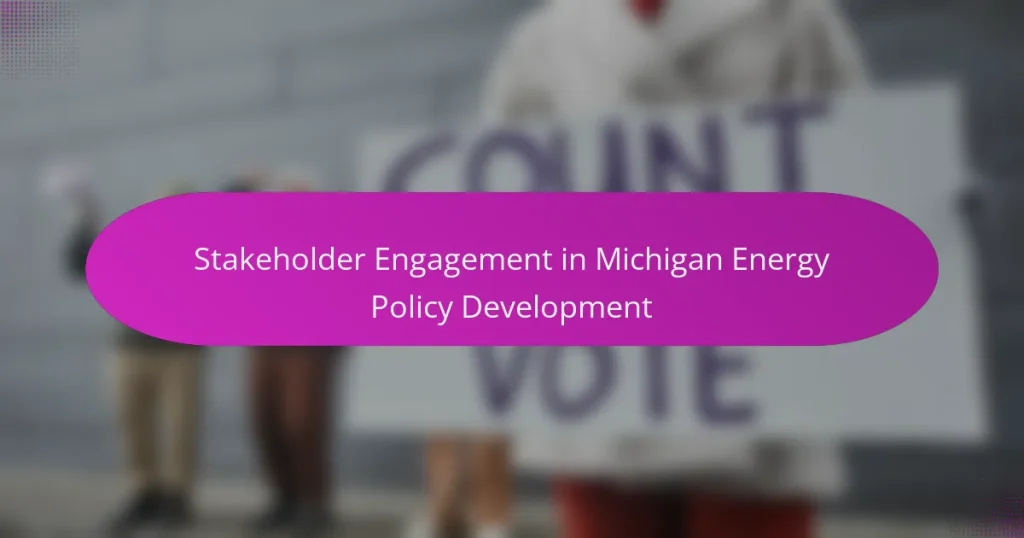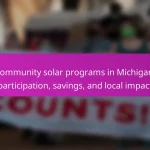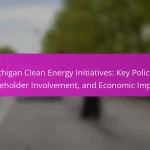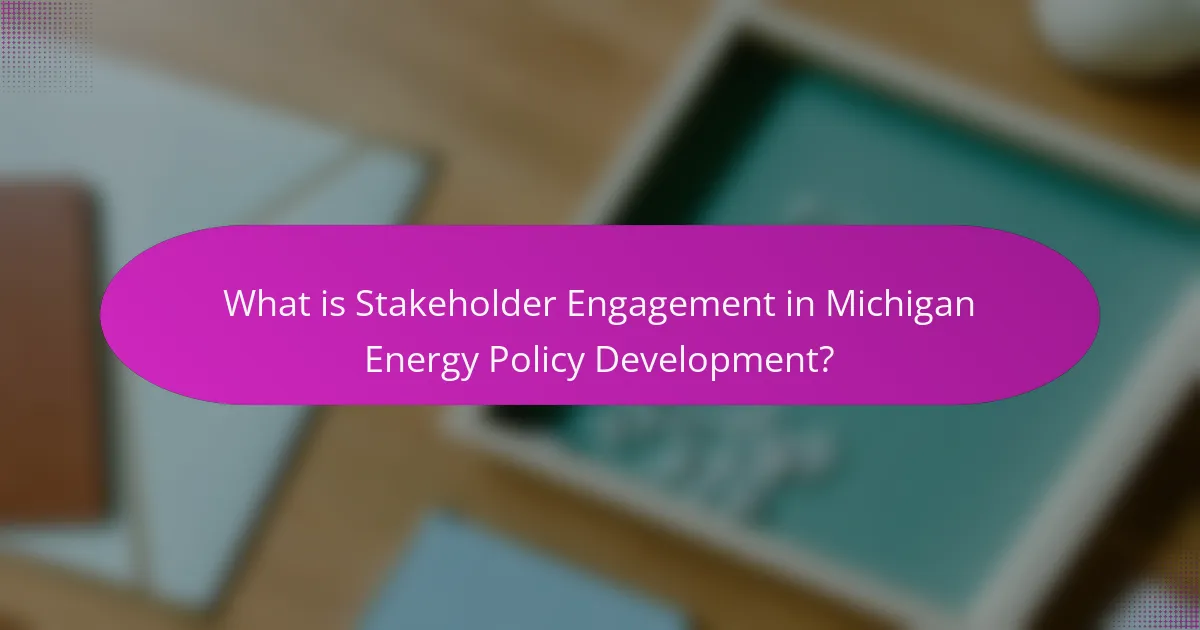
What is Stakeholder Engagement in Michigan Energy Policy Development?
Stakeholder engagement in Michigan energy policy development refers to the process of involving various parties in the formulation of energy policies. This includes government agencies, private sector representatives, non-profit organizations, and community members. The goal is to gather diverse perspectives and insights that influence decision-making. Effective stakeholder engagement fosters transparency and builds trust among participants. It also ensures that policies reflect the needs and concerns of all affected groups. In Michigan, this approach is critical for addressing complex energy challenges and achieving sustainable outcomes. Engaging stakeholders has been shown to enhance policy effectiveness and public acceptance.
Why is stakeholder engagement important in energy policy development?
Stakeholder engagement is crucial in energy policy development because it ensures diverse perspectives are considered. Engaging stakeholders fosters collaboration between government, industry, and communities. This collaboration enhances the legitimacy and acceptance of policies. According to the U.S. Department of Energy, inclusive engagement leads to more effective and equitable energy solutions. Stakeholder input can identify potential challenges and opportunities early in the process. Furthermore, it builds trust and transparency among all parties involved. Research shows that policies developed with stakeholder input are more likely to achieve their intended goals. Therefore, effective stakeholder engagement is essential for successful energy policy development.
What roles do stakeholders play in the energy policy process?
Stakeholders play crucial roles in the energy policy process by influencing decision-making and shaping policy outcomes. They include government agencies, industry representatives, non-profit organizations, and community members. Each stakeholder brings unique perspectives and interests. For example, government agencies provide regulatory oversight and enforce compliance. Industry representatives advocate for business interests and economic viability. Non-profit organizations often focus on environmental and social impacts. Community members contribute local knowledge and concerns. Their engagement ensures diverse viewpoints are considered. This collaborative approach enhances policy effectiveness and public acceptance. Research shows that stakeholder involvement leads to more sustainable energy policies.
How does stakeholder engagement influence policy outcomes?
Stakeholder engagement significantly influences policy outcomes by ensuring diverse perspectives are considered. Engaged stakeholders can provide valuable insights that shape policy decisions. Their involvement often leads to greater transparency and accountability in the policymaking process. Research shows that policies developed with stakeholder input are more likely to be effective and widely accepted. For example, studies indicate that community engagement in energy policy can enhance public support and compliance. This results in more sustainable and equitable energy solutions. Therefore, effective stakeholder engagement is crucial for achieving successful policy outcomes in Michigan’s energy development.
Who are the key stakeholders in Michigan’s energy policy?
The key stakeholders in Michigan’s energy policy include government agencies, utility companies, environmental organizations, and consumer advocacy groups. Government agencies such as the Michigan Public Service Commission play a regulatory role. Utility companies like DTE Energy and Consumers Energy are responsible for energy distribution. Environmental organizations advocate for sustainable practices and policies. Consumer advocacy groups represent the interests of residential and business energy users. Together, these stakeholders influence the development and implementation of energy policies in Michigan.
What government entities are involved in Michigan’s energy policy development?
The primary government entities involved in Michigan’s energy policy development are the Michigan Public Service Commission (MPSC), the Michigan Department of Environment, Great Lakes, and Energy (EGLE), and the Michigan Legislature. The MPSC regulates utilities and oversees energy rates and services. EGLE focuses on environmental aspects of energy policies, including renewable energy initiatives. The Michigan Legislature enacts laws that shape energy policy frameworks. These entities collaborate to ensure comprehensive energy planning and implementation in the state.
Which community organizations and advocacy groups participate in the process?
Community organizations and advocacy groups involved in Michigan energy policy development include the Michigan Environmental Council, the Sierra Club Michigan Chapter, and the Citizens Utility Board of Michigan. These organizations advocate for sustainable energy practices and represent community interests. They participate in public hearings and stakeholder meetings. Their involvement ensures that diverse perspectives are considered in policy decisions. For instance, the Michigan Environmental Council has been active in promoting clean energy initiatives since its founding in 1980. The Sierra Club mobilizes grassroots support for environmental policies. The Citizens Utility Board focuses on consumer protection in utility matters. Their engagement is crucial for shaping effective energy policies in Michigan.
What methods are used for stakeholder engagement in Michigan?
Stakeholder engagement in Michigan utilizes various methods to ensure effective participation. These methods include public meetings, which allow stakeholders to voice their opinions directly. Surveys are also employed to gather quantitative data on stakeholder preferences and concerns. Online platforms facilitate broader participation by enabling stakeholders to engage remotely. Focus groups provide in-depth discussions among selected stakeholders to explore specific issues. Additionally, advisory committees are formed to represent diverse interests and provide ongoing feedback. These methods are designed to foster collaboration and transparency in the energy policy development process.
How are public consultations conducted in energy policy development?
Public consultations in energy policy development are conducted through structured processes that engage stakeholders. These processes typically include public meetings, workshops, and online surveys. Stakeholders, including community members, industry representatives, and advocacy groups, are invited to provide feedback. The goal is to gather diverse perspectives on proposed policies. State agencies often publish discussion papers to inform the public. Consultation outcomes are documented and influence policy decisions. This approach ensures transparency and accountability in the development process. States like Michigan have established guidelines to facilitate effective public engagement.
What digital tools facilitate stakeholder engagement?
Digital tools that facilitate stakeholder engagement include collaboration platforms, social media, and survey tools. Collaboration platforms such as Slack and Microsoft Teams allow real-time communication and document sharing among stakeholders. These tools enhance transparency and foster discussions. Social media platforms like Twitter and Facebook enable organizations to reach a wider audience and gather feedback quickly. Survey tools such as SurveyMonkey and Google Forms help collect stakeholder opinions efficiently. These tools provide valuable data that inform decision-making processes. Research indicates that effective use of these tools can increase stakeholder participation and satisfaction in policy development.
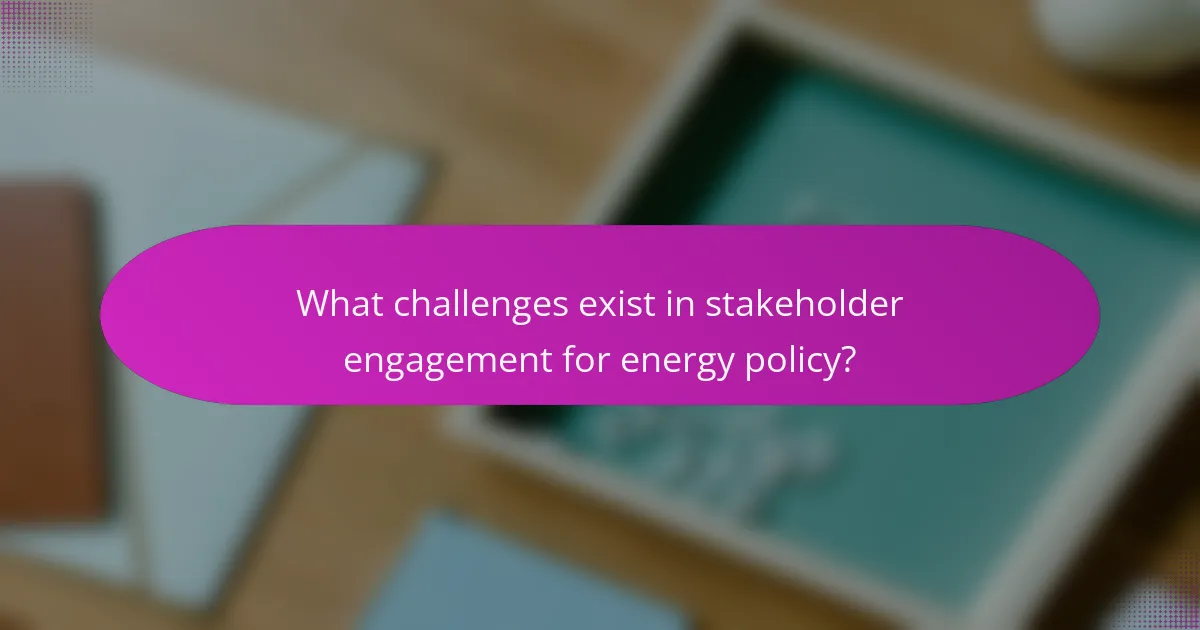
What challenges exist in stakeholder engagement for energy policy?
Stakeholder engagement for energy policy faces several challenges. One major challenge is the diversity of stakeholders involved. Different groups have varying interests and priorities, which can lead to conflicting opinions. For instance, environmental organizations may prioritize sustainability, while industry representatives may focus on economic growth.
Another challenge is the complexity of energy policies themselves. Energy systems are intricate, making it difficult for stakeholders to fully understand the implications of proposed policies. This complexity can result in disengagement or misinformation among stakeholders.
Additionally, there is often a lack of trust between stakeholders and policymakers. Historical grievances or perceived biases can hinder open communication. Effective engagement requires transparency and consistent dialogue to build trust.
Limited resources also pose a challenge. Many stakeholders may lack the financial or human resources to participate actively in the engagement process. This can lead to underrepresentation of certain voices, particularly those from marginalized communities.
Finally, time constraints can affect stakeholder engagement. Policymakers may have tight deadlines, which can limit the opportunity for thorough consultation. This can result in stakeholder feedback being overlooked or inadequately addressed.
What barriers do stakeholders face in participating in the policy development process?
Stakeholders face several barriers in participating in the policy development process. Limited access to information often hinders their involvement. Many stakeholders lack the resources to engage effectively. Time constraints can prevent stakeholders from dedicating necessary hours to the process. Additionally, complex policy language can create confusion and discourage participation. Power imbalances among stakeholders can lead to unequal influence in discussions. Lastly, bureaucratic processes may deter stakeholders due to perceived inefficiencies. These barriers collectively impact the effectiveness of stakeholder engagement in policy development.
How does lack of resources affect stakeholder engagement?
Lack of resources negatively impacts stakeholder engagement by limiting communication and participation opportunities. Insufficient funding can hinder outreach efforts, reducing awareness and involvement among stakeholders. A study by the International Association for Public Participation found that resource constraints often lead to less effective engagement strategies. Consequently, stakeholders may feel undervalued or ignored, diminishing their trust in the process. Without adequate resources, organizations struggle to provide necessary information and support, resulting in disengagement. This can ultimately affect decision-making and policy outcomes, as diverse stakeholder input is essential for effective energy policy development.
What impact does public perception have on stakeholder involvement?
Public perception significantly influences stakeholder involvement. Positive public perception encourages stakeholders to engage actively in policy discussions. When stakeholders believe their input is valued, they are more likely to participate. Conversely, negative public perception can lead to disengagement. Stakeholders may hesitate to contribute if they fear backlash or criticism. Research shows that public trust directly correlates with stakeholder participation levels. For instance, a study by the National Research Council found that stakeholder engagement improves when public perception is favorable. This demonstrates the critical role of public sentiment in shaping stakeholder dynamics.
How can challenges in stakeholder engagement be overcome?
Challenges in stakeholder engagement can be overcome by implementing clear communication strategies. Establishing regular updates and feedback mechanisms fosters trust and transparency. Actively involving stakeholders in the decision-making process enhances their sense of ownership. Utilizing diverse engagement methods, such as surveys and public forums, caters to varying preferences. Training facilitators in conflict resolution can address disagreements effectively. Research by the International Association for Public Participation indicates that inclusive practices lead to better stakeholder relationships. These strategies collectively improve engagement outcomes in energy policy development.
What strategies can enhance stakeholder participation?
Effective strategies to enhance stakeholder participation include fostering open communication, building trust, and ensuring inclusivity. Open communication allows stakeholders to express their views and concerns freely. Regular updates and feedback loops can keep stakeholders informed and engaged. Building trust involves demonstrating transparency in decision-making processes. When stakeholders feel their input is valued, they are more likely to participate actively. Ensuring inclusivity means involving diverse groups in discussions. This approach can lead to a richer dialogue and more comprehensive policy outcomes. Research shows that inclusive stakeholder engagement improves policy effectiveness and community support.
How can transparency improve stakeholder trust in the process?
Transparency can improve stakeholder trust in the process by fostering open communication. When stakeholders have access to information, they feel more included in decision-making. This inclusion builds confidence in the integrity of the process. Clear disclosure of intentions and actions reduces uncertainty. It also allows stakeholders to hold decision-makers accountable. Studies show that organizations practicing transparency experience higher levels of stakeholder satisfaction. For example, a 2020 survey indicated that 85% of stakeholders prefer organizations that share information openly. This trust can lead to stronger collaboration and support for initiatives.
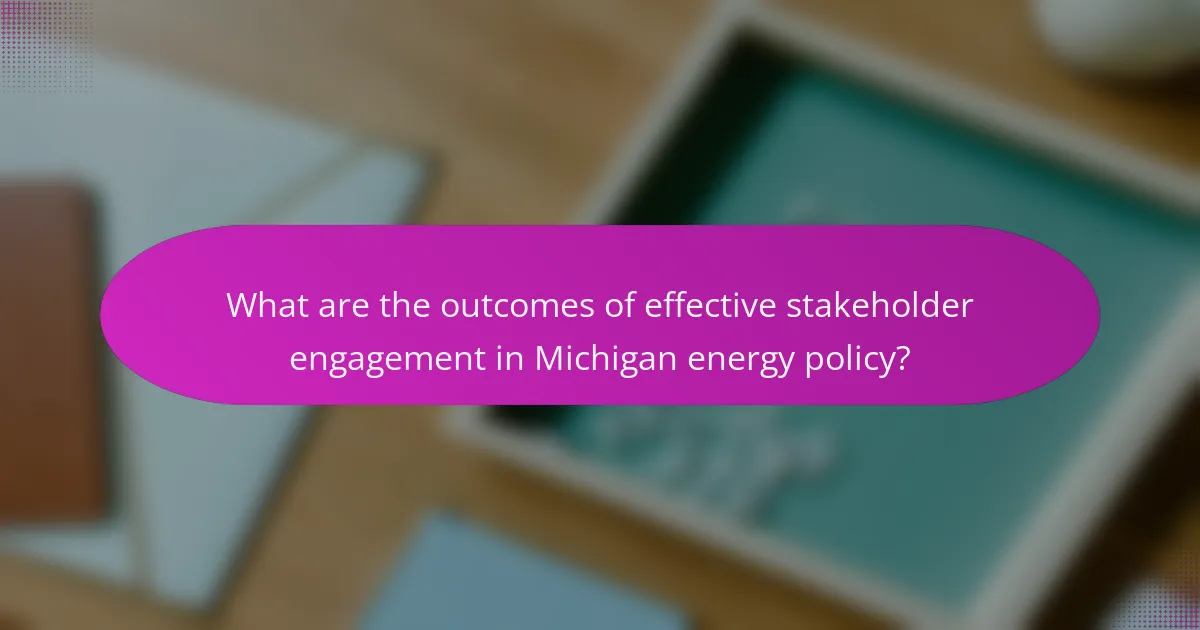
What are the outcomes of effective stakeholder engagement in Michigan energy policy?
Effective stakeholder engagement in Michigan energy policy leads to improved decision-making and enhanced trust among participants. It fosters collaboration between government, utilities, and community members. Engaged stakeholders can provide valuable insights and diverse perspectives. This input helps identify community needs and priorities. As a result, policies are more likely to reflect the interests of various groups. Improved stakeholder relationships can also lead to smoother implementation of energy initiatives. Furthermore, effective engagement can reduce conflicts and opposition to policy changes. Overall, these outcomes contribute to a more sustainable and equitable energy landscape in Michigan.
How does stakeholder engagement lead to better policy decisions?
Stakeholder engagement leads to better policy decisions by incorporating diverse perspectives and expertise. Engaging stakeholders enhances the understanding of community needs and priorities. It allows policymakers to identify potential impacts and benefits of proposed policies. Research shows that inclusive decision-making processes increase public trust and acceptance. For example, a study by the National Academy of Sciences found that stakeholder involvement improves policy effectiveness and sustainability. Collaborative approaches can also lead to innovative solutions that may not emerge in isolated decision-making. Ultimately, stakeholder engagement fosters transparency and accountability in policy development.
What examples show successful stakeholder collaboration in Michigan’s energy policy?
One example of successful stakeholder collaboration in Michigan’s energy policy is the Michigan Energy Efficiency Program. This initiative involves utility companies, state agencies, and consumer advocacy groups working together. They aim to develop energy-saving programs that benefit both consumers and the environment.
Another example is the Clean Energy Coalition, which includes local governments, businesses, and non-profit organizations. This coalition promotes renewable energy and energy efficiency projects across Michigan. Their collaborative efforts have led to increased investment in clean energy technologies.
Additionally, the Michigan Public Service Commission regularly holds stakeholder meetings. These meetings allow various parties, including utilities, environmental groups, and consumers, to provide input on energy policies. This process has resulted in more inclusive and effective energy regulations.
These examples illustrate how diverse stakeholders can come together to shape energy policy in Michigan effectively.
How does stakeholder feedback shape energy policy initiatives?
Stakeholder feedback significantly influences energy policy initiatives by providing diverse perspectives and insights. This feedback helps policymakers understand the needs and concerns of various groups, including communities, businesses, and environmental organizations. Engaging stakeholders fosters transparency and trust in the policy-making process. For example, in Michigan, public consultations and workshops have been conducted to gather input on energy strategies. These efforts ensure that policies are more reflective of community priorities and challenges. Research indicates that inclusive stakeholder engagement leads to more effective and sustainable energy solutions.
What best practices should be followed for effective stakeholder engagement?
Effective stakeholder engagement requires clear communication and active participation. Establishing trust is essential for fostering collaboration. Identify stakeholders early in the process to understand their interests. Regular updates keep stakeholders informed and engaged. Facilitate open dialogue to encourage feedback and address concerns. Use various channels to reach different stakeholders effectively. Document discussions and decisions to ensure transparency. Tailor engagement strategies to the specific context and needs of the stakeholders involved. These practices enhance the quality of stakeholder involvement in energy policy development.
How can policymakers ensure inclusive engagement processes?
Policymakers can ensure inclusive engagement processes by actively involving diverse stakeholders in decision-making. This includes identifying underrepresented groups and providing them with platforms to voice their concerns. Regular outreach and communication efforts can help build trust and encourage participation. Policymakers should also utilize various engagement methods, such as surveys, public forums, and focus groups, to gather input from a wide audience. Transparency in the decision-making process fosters accountability and encourages ongoing dialogue. Evidence shows that inclusive processes lead to more equitable and effective policy outcomes, as seen in successful community engagement initiatives across the U.S.
What ongoing initiatives promote stakeholder engagement in Michigan’s energy policy?
Ongoing initiatives that promote stakeholder engagement in Michigan’s energy policy include the Michigan Energy Efficiency Program and the Integrated Resource Planning process. The Michigan Public Service Commission (MPSC) facilitates these initiatives. They encourage participation from utilities, consumers, and advocacy groups. Regular public hearings and workshops are conducted to gather input. The MPSC also publishes reports and updates to keep stakeholders informed. Collaborative forums allow diverse voices to discuss energy issues. These efforts aim to ensure transparency and inclusivity in energy decision-making.
Stakeholder engagement in Michigan energy policy development involves the active participation of various entities, including government agencies, private sector representatives, non-profit organizations, and community members. This process aims to gather diverse perspectives and insights to influence decision-making, enhance transparency, and build trust among participants. Key stakeholders include the Michigan Public Service Commission, utility companies, and advocacy groups, each playing a vital role in shaping effective energy policies. The article discusses the importance of stakeholder engagement, the methods used for participation, challenges faced, and the outcomes of inclusive practices in achieving sustainable energy solutions in Michigan.
